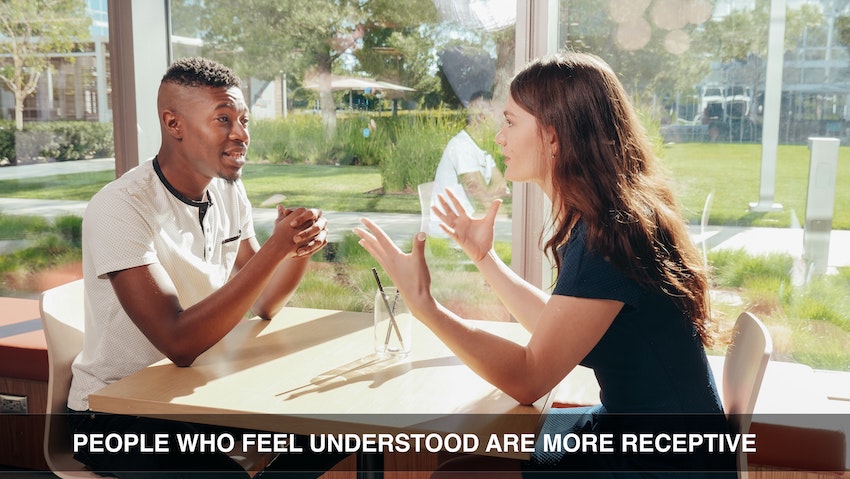How To Calm Someone Down
De-Escalation Skills Training
Refine your communication skills by learning to harness your emotional intelligence with one of the UK's most acclaimed management training courses.
Why Choose This Training?
More Than Just A Course Of Lectures
What gets in the way of developing and holding on to new communication skills are old habits of thinking and speaking. Even if the advice is very good the reason why it rarely sticks are the mental habits people inevitably revert to, especially under pressure.
Unlearning those old habits and internalising a more effective and lasting approach to communication needs more than a short course of lectures on how to do it.
What Makes This Training Stand Out?
What makes this training stand out is the exceptional support through one-to-one coaching sessions and continuous feedback. Changing behaviour is not an easy task as old habits are hard to break.
With a 40-year track record we can help you cultivate practical skills, and build your confidence to so you can successfully navigate real-world challenges, ensuring lasting behavioural improvements.
Testimonials
Join thousands of participants getting results
"What I love about this course is that I didn't just learn about the topic, this course is about ME. I'm confident I can reliably use my new skills, even when under pressure".
![]()
"A lesson for life! The power of effective communication is incredible when one masters the skills "listening with empathy" and "speaking assertively"
![]()
Clients We Have Worked With
Well-known companies who have used this course again and again, over many years
Course Summary
Training Objectives
This course is designed to help you develop your ability to effectively manage and alleviate stress and anxiety at work. This course is designed to empower you with practical skills and strategies to effectively calm their minds, reduce stress and anxiety, and cultivate emotional resilience. On the course you'll learn practical tools and techniques to promote relaxation, enhance emotional well-being, and build resilience. By learning and practicing the strategies covered in the course, participants can expect to learn a range of calming techniques to reduce stress levels. manage anxiety, become more mindful so they can help others achieve more calm and well-being. You'll also learn to cope better and bounce back from stressful situations. You'll developing a repertoire of calming techniques, so you can support your team to build their capacity to manage challenges, adapt to change, and maintain emotional well-being.
Emotional Intelligence
You will learn a set of powerful emotional intelligence communication techniques so that you can manage difficult conversations, handle challenging situations, build relationships and set firm boundaries.
Transferable Skills
The goal of this training is to equip you with the tools they need to build strong, lasting relationships in your professional life, although because these skills are so transferable many clients report vast improvements in their personal relationships as well.
Develop Skills
This is a skills development rather than just a theoretical programme, so the emphasis throughout will be on you taking turn after turn, practising your skills, while receiving feedback and coaching about your effect on others.
Repeated Practice and Feedback
In your coaching sessions you will be helped to practise dealing with the kinds of situation you find challenging, again and again, until you are confident you can do it successfully.
Video Analysis
We'll combine practical, hands-on experience with video replay and analysis and discussion of the principles involved to help you gain both skills and understanding. Special attention is paid to your individual training needs, so you can practise your skills in real-life situations that you have to handle at work.
Sustained Change
That's why as well as your place in a small group, this training includes a generous amount of private and confidential one-to-one coaching sessions online, spread over several months, ensuring an exceptional level of support. This will ensure the changes you make are sustained over a longer period of time and any obstacles are overcome. Choose between online training available worldwide, or in-person face-to-face courses in the UK.
Course Dates and Price
For a list of upcoming course dates (for online coaching and face-to-face training), the locations of the next 3-day public courses in the UK and pricing Click here.
Free Initial Session
This initial coaching session serves as an introduction to the "Skills with People" course, allowing you to understand the course's relevance and effectiveness for your specific needs before committing to it.

What Makes This Training So Effective?
For more than 40 years this communication skills training course has proven to be one of the most highly acclaimed. Over the years we've had thousands of managers and professionals through our hands. Many have said it's one of the best online assertiveness training courses they ever attended.
We have helped our clients develop their confidence to communicate more effectively, and succeed in both their personal and professional lives.
The course content shows how we can help you develop your skills to effectively manage difficult situations and conversations, and help you create a positive work environment.
|
Difficulties People Have |
What You'll Learn on This Emotional Intelligence Training Course |
|
Lack of Empathy |
Learn how to actively listen and understand others' emotions, and practice perspective-taking to better connect with your colleagues. |
|
Communication Issues |
Gain communication strategies for expressing understanding, active listening, and using nonverbal cues effectively to ensure your messages are supportive. |
|
Time Constraints |
Develop time management techniques to prioritise empathetic communication, even in fast-paced situations, fostering more meaningful interactions. |
|
Unfamiliarity |
Acquire techniques for building rapport and trust quickly, allowing you to effectively support individuals, even if you're not familiar with them. |
|
Resistance to Help |
Equip yourself with skills to approach sensitive conversations gently, respecting boundaries and fostering a safe space for sharing. |
|
Cultural Differences |
Explore cultural sensitivity to better understand diverse emotional expressions, enabling you to navigate cross-cultural conversations with respect. |
|
Personal Stress |
Learn self-awareness and self-regulation methods to manage personal stress, so you can offer support with a composed demeanour. |
|
Lack of Regulation Skills |
Develop tools for recognising and managing your own emotions, helping you remain calm while assisting others in distress. |
|
Fear of Confrontation |
Master conflict resolution skills, assertive communication, and strategies for addressing emotions sensitively, even in challenging conversations. |
|
Inappropriate Approach |
Understand appropriate responses such as validating emotions, offering support, and avoiding dismissive behaviours to create a supportive environment. |
|
Misunderstanding the Issue |
Learn to ask open-ended questions and actively listen to fully understand underlying causes of emotional distress, leading to more effective support. |
|
Workplace Hierarchies |
Gain techniques for promoting open and supportive communication regardless of hierarchy, contributing to a healthier workplace dynamic. |
|
Lack of Training |
Acquire comprehensive emotional intelligence, empathy, and conflict resolution skills to offer valuable support to colleagues in need. |
|
Fear of Making Things Worse |
Develop approaches that demonstrate sensitivity and understanding, focusing on support rather than attempting to fix the situation. |
|
Personal Bias |
Increase self-awareness about personal biases and learn strategies to recognise and overcome them, providing unbiased assistance. |
|
Unresolved Past Issues |
Reflect on past conflicts and learn from them, enabling you to approach emotional situations more empathetically and skilfully. |
|
Crisis Situations |
Master techniques for managing high-stress situations, using emotional intelligence to de-escalate tensions and provide effective support. |
|
Lack of Privacy |
Gain guidance on finding suitable spaces for private conversations, ensuring confidentiality and emotional privacy during discussions. |
|
Cognitive Load |
Learn techniques to manage cognitive load, switch focus, and engage in empathetic conversations effectively, even amidst other tasks. |

Learning Objectives
Work-related stress is a common problem, especially during difficult times. Whether it's an angry outburst from a coworker or increased pressure due to tight deadlines, the impact on employees and the workplace can be huge.
Learning how to calm someone down at work is essential in maintaining a positive work environment that allows everybody to thrive. On this training course you’ll learn strategies for calming someone down. Active listening and empathetic response are the main strategies. Here we will also discuss mindfulness techniques and physical techniques as well as when you might benefit from some professional help.
Managing work - related stress is essential for creating a healthy and productive environment in the workplace
Actively listening to employees, expressing empathy, using mindfulness techniques and physical exercises can help reduce stress levels within an organisation.
Developing positive environments in which employees feel understood and validated leads to higher job satisfaction among colleagues.
Encouraging collaboration through supportive behaviour helps foster strong team dynamics while eliminating feelings of burnout amongst workers.

Understanding Work-Related Stress
Work-related stress can have a negative impact on employees and the workplace, such as low morale, decreased productivity, delays in completing tasks, dissatisfaction with management, and poor job performance.
Causes Of Work-Related Stress
Work-related stress stems from an array of factors, and can cause serious physical and psychological damage if not addressed effectively. The six main areas that can lead to work-related stress, which must be managed properly, include demands, control, support, relations with colleagues and supervisors, role conflict/ambiguity as well as change at work.
When it comes to demands in the workplace long hours or heavy workloads may cause employees to become overwhelmed due to a lack of adequate resources or support.
Additionally job insecurity caused by uncertain futures within an organisation can also increase a sense of anxiety among workers. In terms of interaction between coworkers or superiors. Conflicts in communication styles along with negative feedback or criticism can create feelings of frustration and helplessness for those involved.
Role ambiguity is another major factor that causes work-related stress. When staff members do not know what’s expected from them they experience confusion leading to uncertainty about their performance levels, often resulting in lower morale overall.
Understanding how each area affects workplace wellbeing is key for ensuring the productivity of individuals while promoting a healthier environment both mentally & physically. For example addressing underlying causes such as workload management & providing better training/support systems will create greater autonomy. This in turn can lead people to experience less strain, which means your organisation is more likely to achieve goals faster, whilst simultaneously maintaining harmony which will further boost everyone’s well being.
Impact On Employees And The Workplace
Work-related stress can have a significant negative impact on both individuals and the workplace. When excessive amounts of stress are present in the work environment, employees may experience feelings of fear, anxiety or vulnerability that can lead to decreased productivity levels.
Increased emotional distress from work-related stress or burnout can lead to physical symptoms such as headaches and fatigue which may further diminish job performance.
Not only does work-related stress effect individual employees but it has far reaching effects on organisations overall too. According to some studies productivity issues stemming from overwhelmed staff members cost companies approximately hundreds of billions annually which is equal to nearly 5% of global GDP (Gross Domestic Product).
This shows just how important it is for employers, leaders and corporate culture proponents alike to take proactive steps towards preventing unnecessary sources of tension whenever possible so that people feel more secure emotionally during working hours.
Importance Of Calming An Upset Person Down At Work
Know how to calm someone down at work is vital if you are interested in maintaining a productive and happy working atmosphere. It is necessary for the good quialy workplace dynamics, productivity, and overall emotional well-being.
Benefits Of Reducing Stress And Anxiety In An Angry Person
Reducing stress and anxiety levels in workplace has numerous benefits. Research suggests that chronic stress can have long-term physical and psychological side effects, including weakened immune system, high blood pressure, tension headaches, fatigue and depression.
It can also reduce the effectiveness of job performance, as stress Impairs people ability to thinking strategically and has been shown to decrease creativity. On the other hand, reducing stress leads to multiple improvements at work such as improved communication between employees, which can lead to a more efficient workplace environment with better results, increased collaboration among team members resulting in enhanced productivity. On top of that better mental well being ensured through regular breaks from stressful tasks providing higher job satisfaction among colleagues.
Recent studies show that using relaxation techniques such as mindfulness meditation lowers cortisol (the primary hormone of stress) by 17%. Other tactics for managing work-related strain include speaking openly about issues or practicing be active exercises (e.g., stretches) during short breaks throughout the day to aid concentration skills (higher focus on details).
Allowing space for a person talk and listening alone with no feeling of judgment helps people communicate thoughts and fears, allowing them becoming more self aware. If you can help people to realise how they feel, you can help them become more capable at gaining effective control over emotions, which reduces the likelihood of angry outbursts, and feeling of insecurity about their feelings or fear in uncertain situations. This may sound counter-intuitive, but being able to confront feelings, reduces their impact, rather than exacerbating them.

How to Foster A Positive Work Environment
Creating a positive work environment reduces stress levels, improving employee morale and collaboration, and ultimately creating a successful work climate.
A positive work environment doesn't just help employees. Managers also benefit from cultivating an atmosphere of trust and respect in the workplace. Encouraging positivity can lead to more motivated teams and higher job satisfaction.
Employers that prioritise onboarding programs, and inform new people about the company mission statement or values, and regularly check-in with people help create accountability among team members, while communicating expectations among managers so everyone on the team feels comfortable querying questions or expressing concerns without fear.
Mindfulness exercises such as deep breathing are beneficial for calming anxious moments when managing projects or crises arise at work. Leading through example by practicing mindful techniques yourself can give your staff an understanding of how this provides insight into potential solutions for resolving conflicts amongst each other if needed be down the line.
On top of these mindfulness practices, employers should ensure employees take full use of their breaks throughout the day to recharge themselves physically, emotionally, mentally rather than just eating lunch at their desks during break time which can lead to exhaustion rather than uplifting energy post shift changes.
Taking note of people’s workloads, and ensuring they remain challenging yet reasonable, showing appreciation through recognition whether it be publicly (team wide emails) or privately (handwritten cards) will increase their confidence levels and boost their engagement.
Treating employees well, and with kindness generates trusting relationships between employer and employee. Make sure you communicate openly, so that they feel more comfortable bringing any grievances to you, without worrying about any threats or that they may jeopardise their relationship with you if they are not happy about something.
Enhancing Productivity And Collaboration
By fostering collaboration and promoting productive environments, employers can build a strong workplace culture that will contribute to reducing stress.
Teams will be more energised when people feel part of a community instead of feeling isolated in their job roles. Collaborative activities such as working on group projects, establishing rituals for meetings and understanding team goals can foster better communication between employees.
When employees understand the objectives they are working towards they are less likely to feel overwhelmed by individual tasks. Setting boundaries such as work hours, deadlines and expectations around response rates encourages effective time management which leads to improved productivity among the entire team.

Active Listening: A Key Strategy For Calming Someone Down
By taking the time to actively listen and show empathy to someone who is upset, you can help them process their emotions in a healthy way.
Listen Attentively And Show Empathy
One of the best ways to calm someone down at work is to listen attentively and show empathy. Empathy is a vital part of calming individuals as it demonstrates that you understand their feelings without judgement or criticism.
Active listening, which includes using reflection, allows other people to feel heard and understood. By repeating back what they have said in your own words, the other person will have confirmation that you are paying attention and respect their life story enough to hear and remember it clearly.
Reflecting on how a person feel what they may be feeling in response helps validate their emotions which can help them feel less overwhelmed with distress or anger. On this training course we’ll not only show you how to do this, you’ll practice it over and over until you’re really confident you know exactly what you’re doing, and you can do it really well.
Use Paraphrasing To Clarify Concerns
Paraphrasing is a powerful tool for active listening and helps to clarify concerns when trying to calm someone down at work. When talking with an upset employee, it's important to actively listen and demonstrate understanding by not only hearing what they have said but also reflecting back information in your own words.
Paraphrasing can help the speaker feel heard and ensure both parties understand each other.
When paraphrasing always make sure to give brief summaries of main points highlighted by the speaker as well as reflect back their emotions. This will show them that you are understanding their perspective without judgement while helping keep the conversation succinct and manageable.
Whenever technical or unfamiliar terms come up during discussion, take time out of the conversation to explain these terms further in understandable language. This helps reduce the chances of misunderstandings and miscommunications.
Ask Open-Ended Questions
Open-ended questions can be very effective for helping to calm someone down in the workplace. Unlike closed-ended or yes/no questions, open-ended questions allow a speaker to provide an elaborate response beyond a simple yes or no answer.
This opens up the conversation and allows for more information to be shared.
Examples of open-ended questions include: "Can you tell me what happened?" "What thoughts do you have about this situation?”, “How can I help?” Open-ended questioning also allows people to express their feelings without judgement while simultaneously allowing them to feel heard and understood by giving them the opportunity to elaborate on their perspectives and experience in more detail than possible with closed ended questioning.

Empathy: A Key Skill For Calming Someone Down
By listening attentively, empathising with another's feelings and encouraging problem-solving skills, an individual can help calm a coworker in distress.
Validating The Person's Feelings
Validating someone's feelings can be an effective strategy for calming them down in the workplace. It is important to acknowledge people’s emotions, as it can help them feel safe and comfortable enough to express how they are feeling.
Validation also helps build empathy and trust as it shows that you care about what they are going through and want to support them.
Validation typically involves listening attentively, showing understanding of the person’s viewpoint without judgment or criticism, being aware of non-verbal cues like body language and facial expressions, making sure that their voice is not spoken over or stifled during the conversation.
An example of how you might validate another upset person who’s upset feelings could be “If I were in your situation I think I might also feel unhappy about it, because ...”
Offering Reassurance And Support
Providing reassurance and support can make a big difference when calming someone down at work. Reassurance involves showing that you care, empathy, and compassion. It means listening actively and validating the other person’s feelings while offering support in managing their concerns.
People tend to be less agitated if they feel that they have been heard or given attention to. On this training course you’ll have an opportunity to learn exactly how you can reassure someone that you are taking them seriously, that you care about them, and that you wish them to feel better.
Encouraging Problem-Solving Skills
Encouraging problem-solving skills is a key element to calming someone down at work. Identifying the root cause of an issue and brainstorming potential solutions can be beneficial for helping people address their concerns in healthier ways.
In high stress environments, this technique can help shift attention away from negative thoughts and feelings that lead to increased tension or worse, burnout. Problem-solving also creates opportunities for employees to come together as a team and collaborate on creating resolutions that benefit everyone involved.
Research has shown that people who actively participate in problem-solving are more emotionally resilient and better equipped with strategies they need for dealing with future challenges in the workplace. It helps reduce stress levels, fosters supportive relationships between coworkers, improves communication styles, promotes collaboration among teams members, enhance productivity as well as enable employees to feel heard and valued within their professional setting.
For instance, handing out surveys or holding discussions amongst staff about how they’re impacted by certain issues may allow them to evaluate difficulties openly without fear of judgement or repercussions, which is a great strategy when it comes to alleviating stressful situations at workplaces.
Problem-solving techniques can go a long way towards calmer office dynamics particularly when managing conflicts or other difficult circumstances.
Recommending Deep Breath Techniques And Breaks As Needed
When it comes to calming someone down at work, recommending breathing techniques and breaks can be very effective. Breathing exercises are an easy, affordable way to manage stress levels and help restore an emotional state and balance in tense situations.
Deep breathing increases the amount of oxygen in our bodies, calming us both mentally and physically. It is particularly helpful for those experiencing stressful or anxious moments as it mimics the natural "relaxation response" by slowing down heart rate and releasing stress hormones such as cortisol from their system.
Regular breaks during work hours can also provide a sense of calmness for any situation.

Mindfulness Techniques For Calming Someone Down
Mindfulness techniques include mindfulness exercises, guiding the person through deep breathing techniques, and recommending guided meditation sessions to enhance focus and clarity.
Suggesting Mindfulness Exercises
Mindfulness is an excellent way to help calm someone down at work. Mindful moments during the day can help us gain emotional control and reduce stress, anxiety, and depression.
The practice of mindfulness involves being present in the moment. By focusing on our body's physical sensations, emotions, thoughts, or breathing patterns without judgment or expectations it allows people to become more aware of how their physical and mental states are interconnected.
Suggesting specific mindfulness exercises is also helpful for calming someone down at work. An example exercise would be mindful eating. This involves paying close attention as we eat each bite with no distractions like television or phones.
Practicing deep breaths throughout the day can also help calm anxious, angry or frustrated feelings that arise from deadlines or difficult co-workers. 10-15 slow inhales and exhales every few hours will bring oxygen into the muscles and helps relaxation.
Taking breaks periodically during long days such as short guided meditations (even if only 5 minutes) to focus on breath work has been found valuable for even just reducing cortisol levels (a stress hormone).
Guiding The Person Through Deep Breathing Techniques
Deep breathing exercises can be an effective way to help calm someone down at work and reduce stress. Studies have shown that deep Breathing techniques can lower the levels of stress hormone cortisol in the body, helping increase relaxation and wellbeing.
When guiding someone through deep breaths it is important to ensure they start off slowly with longer inhales than exhales; this helps increase oxygen intake which may lead to more relaxed muscles for improved overall relaxation.
Explaining how focusing their attention on each physical movement associated with their breath can also help keep them focused on the task at hand during times of distress or anxiety.
Recommending Guided Meditation Sessions
Guided meditation is an effective and natural way to help calm someone down at work. Research has shown that incorporating mindfulness into our regular routines can have positive effects on both overall health and mental well-being.
Mindfulness practices like meditation involve breathing methods, guided imagery, and other exercises to help reduce the stress hormone cortisol levels, lower blood pressure, decrease anger responses, improve focus and concentration, foster a sense of emotional connection with others in the workplace, manage anxiety efficiently in stressful situations as well as create trust within employees’ relationships.
Being able to recognise when your work environment may be too intense or overwhelming is key for taking proactive action immediately before the situation escalates further.
Offering simple suggestions such as mindful strategies can help calm people down. Suggesting a few minutes of deep breathing or guided meditation which can shift the person's energetic state from heightened emotions back down to a point of feeling more relaxed. This enables them to approach whatever issue they might face from a calmer mindset equipped better for logical decision making over untempered irrational reactions.

Physical Techniques For Calming Someone Down At Work
Encouraging light exercises, stretches, or a walk can help to ease anxiousness in turbulent situations and restore natural calming hormones.
Encouraging Light Exercises, Stretches, Or A Walk
Physical activities such as light exercises, stretches, and walks are an effective way to reduce stress in the workplace. These types of activities can help to improve posture and increase muscle activity in order to promote a healthier work environment.
Light stretching throughout the day or even during quick breaks can help employees stay alert and productive instead of feeling sluggish while at work. A short walk around the office building during lunchtime or after hours can provide employees with a much-needed break from being cooped up inside all day long.
These physical activities are great tools for calming someone down as they provide more control over one person's anger and emotions which will be beneficial both personally and professionally.
Yoga poses like Triceps Stretches or Overhead Reach can be done in seconds before beginning any project. This does not have to take away time from actual work tasks but rather make it easier for them to be accomplished without experiencing extreme frustration or fatigue towards them later on in the day.
Deep breaths that focus on breathing into certain parts of your body breathe out even deeper tensions also works wonders when it comes calming nerves at work. Doing so increases energy levels throughout the entire body while also improving mental clarity by allowing clearer modes of thinking within stressful situations, something most people struggle with on some occasions (or regularly).
Offering A Hot Or Cold Drink
Temperature has a powerful effect on the body and can help calm workplace anxieties. For example, sipping on a warm drink on a cool day can make one's body feel comfortingly warm and almost like a physical hug, providing an instant feeling of peace.
Different types of warm drinks contain various calming herbs and compounds that people can rely upon in times of distress or tension at work.
Not only do certain drinks offer mental comfort but they also provide psychological solace. By offering someone a hot or cold drink, it conveys care from another person in the office which helps to lower stress hormones such as cortisol pumped during moments of anger or angst.
It provides assurance that their feelings are taken seriously and signifies recognition of the individual’s condition by their colleague, creating trust among members in the workplace environment for improved collaboration.

Knowing When To Seek Professional Help
When someone is struggling with work-related stress and anxiety, it may be best to seek professional help. Encouraging employees to talk to a mental health professional or counsellor can provide them with the support they need in order to manage their emotions and find constructive solutions.
Identifying Signs Of A Mental Health Crisis And Burnout
Employees who are stressed, anxious, or overwhelmed can suffer from impaired performance at work. It’s important for leaders, managers and colleagues to be aware of the signs of a mental health crisis or burnout in order to take action as soon as possible.
Common symptoms may include sleep disturbances such as difficulty falling asleep or sleeping too much, changes in appetite resulting in weight gain or loss, fatigue even after restful sleep and increased absenteeism due to physical exhaustion.
People experiencing a mental health issue may also show up late more often than usual or have difficulty focusing on tasks. Depression is another potential factor that needs attention with feelings of sadness being the most common symptom along with hopelessness and worry about the future.
People may self-medicate by using substances including alcohol and drugs which negatively influences job performance and overall wellbeing mentally and physically.
As burnout is related to chronic stress over time people need additional support if they are beginning to experience these effects like working excessive hours without breaks leading to depletion of energy reserves leading further away from feeling happy in their place of employment.
Encouraging Employees To Seek Professional Help
Encouraging employees to seek professional help is an important part of creating a supportive work environment that promotes mental health and well-being. Professional help can provide specialised care, quickly identify underlying issues, and treat them more effectively than people’s family or friends could.
In the long run, seeking out professional helps prevents further psychological distress and encourages employees to become proactive in maintaining their own emotional health in the workplace.
Examples of such support include having conversations with coworkers about seeking therapeutic support when needed, sharing helpful resources online or in meetings for mental health services near where they work or live, offering to be available for moral support if assistance is required at initial appointments, and checking up regularly on colleagues who have expressed interest in accessing counseling.
Employers also play an incredibly crucial role not only through providing treatments but also by establishing stigma-free workplaces that allow staff members to prioritise their own emotional wellbeing without any fear or judgment from management.
Offering Resources And Support
It is important for employers to have resources and support systems in place which employees can access when needed. These resources can include Employee Assistance Programs (EAPs) that offer confidential, professional advice on a range of issues; this could be anything from financial worries to marriage counselling.
Having these services in house will allow employees the freedom to discuss their concerns without feeling judged or embarrassed.
Good workplaces strive to create an environment where it is okay for people to talk openly about mental health. They create an environment where people don’t have to feel pressure minimise their bad or sad feelings, so it’s not just a person ˜having a bad day”. If instead, you can recognise they are going through something, and give them an opportunity to express themselves freely with little judgement or apprehension it will pay off in the long run.
Offering relevant training courses help increase awareness by equipping managers with the skills and understanding necessary when dealing with mental health related issues at work.

The Importance Of Compassion And Support In The Workplace
Having a workplace with compassion and support is essential in creating an environment that encourages creativity, well-being, and innovation. Research shows that providing empathy to employees leads to higher job satisfaction as workers feel understood and validated for their emotions.
When we show genuine appreciation for our coworkers performances, and express interest in their personal situations, it builds camaraderie among team members even when faced with difficult tasks or challenging projects.
The atmosphere of compassion can cultivate increased productivity since people are more likely to negotiate better solutions when met with kindness rather than criticism.
Being part of a supportive work community results in fewer sick days for employees due to reduced stress levels while simultaneously enhancing morale across departments.
To establish this type of successful working environment requires management staff possess excellent communication skills and understanding of human behaviour. Employers can encourage active listening within teams so everyone feels heard when they share ideas which can then be acted on quickly during meetings or brainstorming sessions resulting in positive outcomes all around. Good managers seek out feedback from team members regularly so changes made are both beneficial cost-wise and have an impact on employee empowerment too. On this training course we can help you become skilled at bringing out the best in your team.

How to Calm Someone Down At Work FAQs
What are some strategies for calming someone down at work?
Strategies for calming someone down at work include acknowledging their feelings, listening without judgement, helping them identify the source of stress and providing reassurance or advice if appropriate. Offering a small break from the situation could also help the person remain calm and alleviate any tension they may be feeling while allowing emotions to neutralise in a less confrontational environment.
How can I effectively listen to someone who is upset?
When listening to employees when they're upset it's important to stay focused on what they’re saying without jumping into conclusions prematurely or directing conversation towards preferred outcomes as this could feel invalidating and rushed, and may only serve to further exacerbate negative symptoms. Repeating back the main points of the person feel emotion they are expressing during conversations ensures they are more likely to feel understood, and could even provide helpful clarifying moments if issues weren't immediately obvious.
What should I do if an employee doesn’t seem interested in talking about the problem?
If an employee isn't interested in addressing problems associated with current issue or situations then sometimes giving them space and time away might be necessary. In that way people aren’t forced into discussing topics against their will. Although this approach certainly has drawbacks, especially since nothing will get resolved.
What resources can employers provide after experiencing a stressful day?
Employers should consider having mental health resources readily available which staff members can access whenever needed. These programs often combine counselling services alongside. Also, building strong rapport is crucial to ensure employees trust managers throughout process. That will make it much more likely they’ll feel comfortable confiding in their manager that they feel anxious or distressed, and are able to get on top of it more quickly.
How can I calm someone down when they are angry at work?
- When someone's anger flares up at work, it's essential to approach the angry person or situation with a calm voice and remain composed yourself. Take a deep breath and focus on staying calm.
What can I do to help someone calm their own feelings of stress and anger?
Encourage the person to talk about their emotions and express themselves. Remind them that their feelings are valid and that it's important to recognise and address their own emotions.
What if the person doesn't want to talk about their anger?
If the upset or angry person still is not ready to talk about their anger, respect their boundaries. Let them know you're there for support whenever they feel comfortable discussing their concerns.
How can I offer support to a coworker who is stressed or angry?
Offer to lend this person an ear or be a sounding board for this person talk through their frustrations. Let them know you understand that they might be dealing with a hard time and that you're there to support them.
What if the person's anger issues are affecting their work and relationships?
If someone's anger issues are negatively impacting their work or relationships, it might be helpful to suggest that person get professional help or counselling. Recommend that upset person that they speak with a trusted friend, family member, or seek assistance from a mental health professional.
How can I help someone remain calm in stressful situations?
Encourage the person to take deep breaths and practice deep breathing exercises. Deep breaths have a calming effect on the body and help promote rational thought and emotional stability.
What can I say to someone who is feeling overwhelmed at work?
You can say something like, "I understand that you're feeling overwhelmed right now. It's important to take a moment to recognise your emotions and address your concerns. Is there anything specific I can do to support you?"
How can I help a colleague improve their self-esteem in the workplace?
Offer words of encouragement and remind them of their strengths and accomplishments. Let them know that their contribution is valued and that they have the power to overcome challenges.
What steps can I take to deal with someone's anger while remaining calm myself?
When someone's anger escalates, it's crucial to stay calm and composed. Practice active listening, pay attention to their concerns, respond and validate their emotions without getting defensive.
How can I support a friend or coworker who is going through a tough time in their personal life?
Show understanding and empathy toward their own life situation. Let them know that you're there to listen, hear, and offer advice if they need it. Sometimes, simply being present and supportive can make a significant difference in their lives.





















